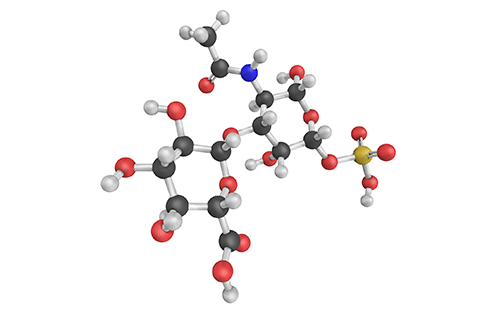From the journals: MCP
Amino acids and sulfate signatures. Unveiling phosphatase substrates. Simplifying bacterial proteome profiling. Read about papers on these topics recently published in the journal Molecular & Cellular Proteomics.
Amino acids and sulfate signatures

Chondroitin sulfate proteoglycans, called CSPGs, are complex molecules that surround cells and provide not only structural and biochemical support to various tissues in the human body, including the nervous system, cartilage, bone and connective tissues, but also influence organ differentiation and regeneration. They are comprised of a core protein to which chondroitin sulfate chains, or CS chains, are attached at specific serine residues. CS chains are long, linear sugars composed of repeating often sulfated units of glucuronic acid and N-acetylgalactosamine.
Sulfation can occur at different positions on the amino sugar and the uronic acid, leading to various sulfation patterns. These variations contribute to the diverse biological functions of chondroitin sulfate. Core protein structure, CS chain length and sulfation patterns vary widely in CSPGs, complicating the characterization of a standard representative sequence for a given CSPG. Chondroitin sulfate signatures may serve as biomarkers for certain diseases or conditions. Identifying unique patterns associated with specific health states can aid in the development of diagnostic tools.
Mass spectrometry is a powerful tool for sequencing CSPGs, but technical challenges still exist in determining how CS structures vary among them. In a recent article published in Molecular & Cellular Proteomics, Fredrik Noborn and colleagues from the Institute of Biomedicine at the University of Gothenburg report a novel glycoproteomics approach for characterizing the sequence of CS modification at specific sites of attachment to the core proteins.
With a combination of CS glycopeptide enrichment, using strong anion exchange chromatography, depolymerization of CS polysaccharides and nanoscale reversed-phase liquid chromatography-tandem mass spectrometry, the authors determined the sulfation patterns of CS in protein attachment sites of CSPGs in human urine samples. The approach showed that the acidity of amino acid sequences around the CS attachment site corresponds to higher sulfation levels in the CS chains. This approach will help researchers analyze the structure-function relationships of CSPGs in the future, which can guide the design of drugs for diseases with altered CSPG modifications.
Unveiling phosphatase substrates
The dynamic interplay between protein phosphorylation and dephosphorylation is fundamental to many cellular processes. Protein kinases and protein phosphatases are enzymes that add or remove phosphate groups to proteins, respectively, typically on serine, threonine or tyrosine amino acid residues. With advances in mass spectrometry and proteomic technologies, scientists have discovered thousands of protein phosphorylation sites. However, researchers have confirmed that less than 10% of these sites are phosphorylated by kinases and less than 1% are dephosphorylated by phosphatases.
A recent study published in the journal Molecular & Cellular Proteomics, led by Natasha C. Mariano and colleagues from the Geisel School of Medicine at Dartmouth, shows the potential for CRISPR-Cas9 gene editing, auxin-inducible degron, or AID, tagging system in conjunction with quantitative mass spectrometry and phosphoproteomics to identify dephosphorylation sites in cells. To validate this approach, the researchers determined the dephosphorylation sites for a serine-threonine phosphatase enzyme, protein phosphatase 6, also known as PP6.
The authors report a direct role for PP6 in regulating the function of Monopolar spindle-one-binder proteins, or MOB1, by dephosphorylating threonine 35 residue. This study links PP6 to the phosphorylation-based interaction of MOB1 and large tumor suppressor kinase, or LATS, a key player in the Hippo signaling pathway. The PP6 mutation in certain cancers such as melanoma leads to hyperactivation of the rapidly accelerated fibrosarcoma/mitogen-activated protein kinase/extracellular signal-regulated kinase, or RAF-MEK-ERK, signaling pathway. This signaling cascade often shows resistance to drugs, leading to therapeutic failure. Hence, effective multiplexed phosphoproteomic approaches that explore the signaling activities of individual phosphoprotein phosphatases will help design therapeutics that bypass drug resistance in cancers.
Simplifying bacterial proteome profiling
Bacterial proteomes can be complex and dynamic, varying across different growth conditions, stages of growth and environments. Heterogeneity in bacterial populations adds a layer of complexity, making it challenging to capture the full diversity of the proteome in a single quantitative proteomic workflow. Bacterial proteome analysis also involves handling live microorganisms, presenting biosafety concerns.
In a recent study published in the journal Molecular & Cellular Proteomics, Miriam Abele and a team at the Technical University of Munich report a safe, rapid, single-shot quantitative workflow for bacterial proteome characterization. The workflow combines microflow liquid chromatography with data-independent acquisition methods in a liquid chromatography–mass spectrometry system to achieve quick and superior open reading frame coverage of the proteome, as high as 65%. Conducting bacterial cell lysis using 100% trifluoroacetic acid eliminates the need for a bead-beating step or specialized instrumentation and ensures the safe handling of microbes.
The authors tested the workflow in 23 diverse bacterial species and performed a comparative proteome expression analysis encompassing 72 samples, illustrating the workflow's benefits in high-throughput applications. The proposed approach unlocks possibilities for bacterial proteomic studies on a large scale.
Enjoy reading ASBMB Today?
Become a member to receive the print edition monthly and the digital edition weekly.
Learn moreGet the latest from ASBMB Today
Enter your email address, and we’ll send you a weekly email with recent articles, interviews and more.
Latest in Science
Science highlights or most popular articles

Scientists identify new function of learning and memory gene common to all mammalian brain cells
Findings in mice may steer search for therapies to treat brain developmental disorders in children with SYNGAP1 gene mutations.

From the journals: JBC
Biased agonism of an immune receptor. A profile of missense mutations. Cartilage affects tissue aging. Read about these recent papers.

Cows offer clues to treat human infertility
Decoding the bovine reproductive cycle may help increase the success of human IVF treatments.

Immune cells can adapt to invading pathogens
A team of bioengineers studies how T cells decide whether to fight now or prepare for the next battle.

Hinton lab maps structure of mitochondria at different life stages
An international team determines the differences in the 3D morphology of mitochondria and cristae, their inner membrane folds, in brown adipose tissue.

National Academies propose initiative to sequence all RNA molecules
Unlocking the epitranscriptome could transform health, medicine, agriculture, energy and national security.

